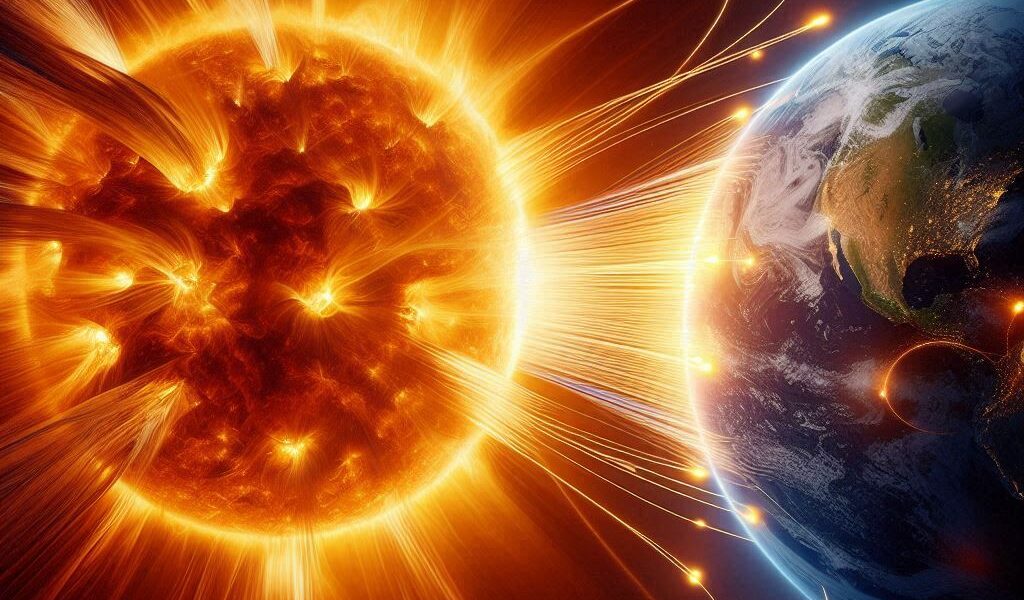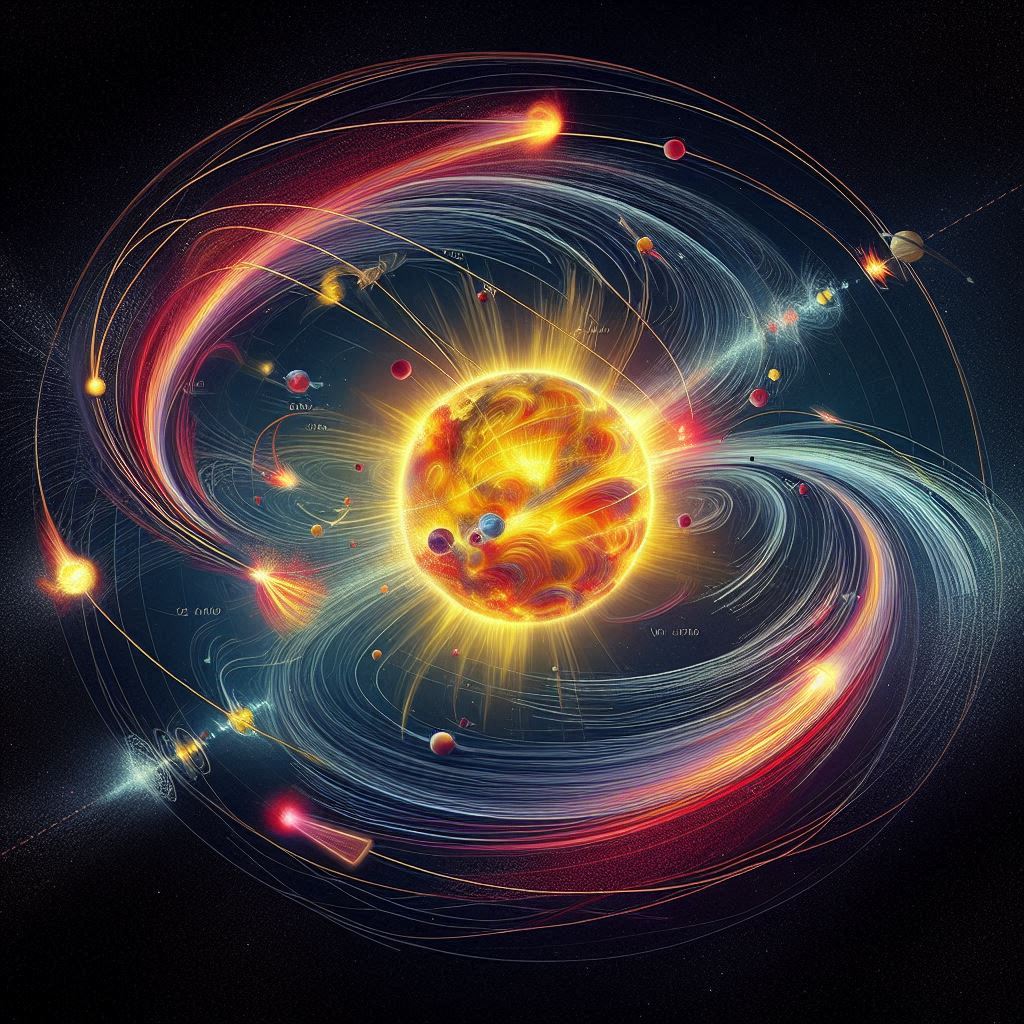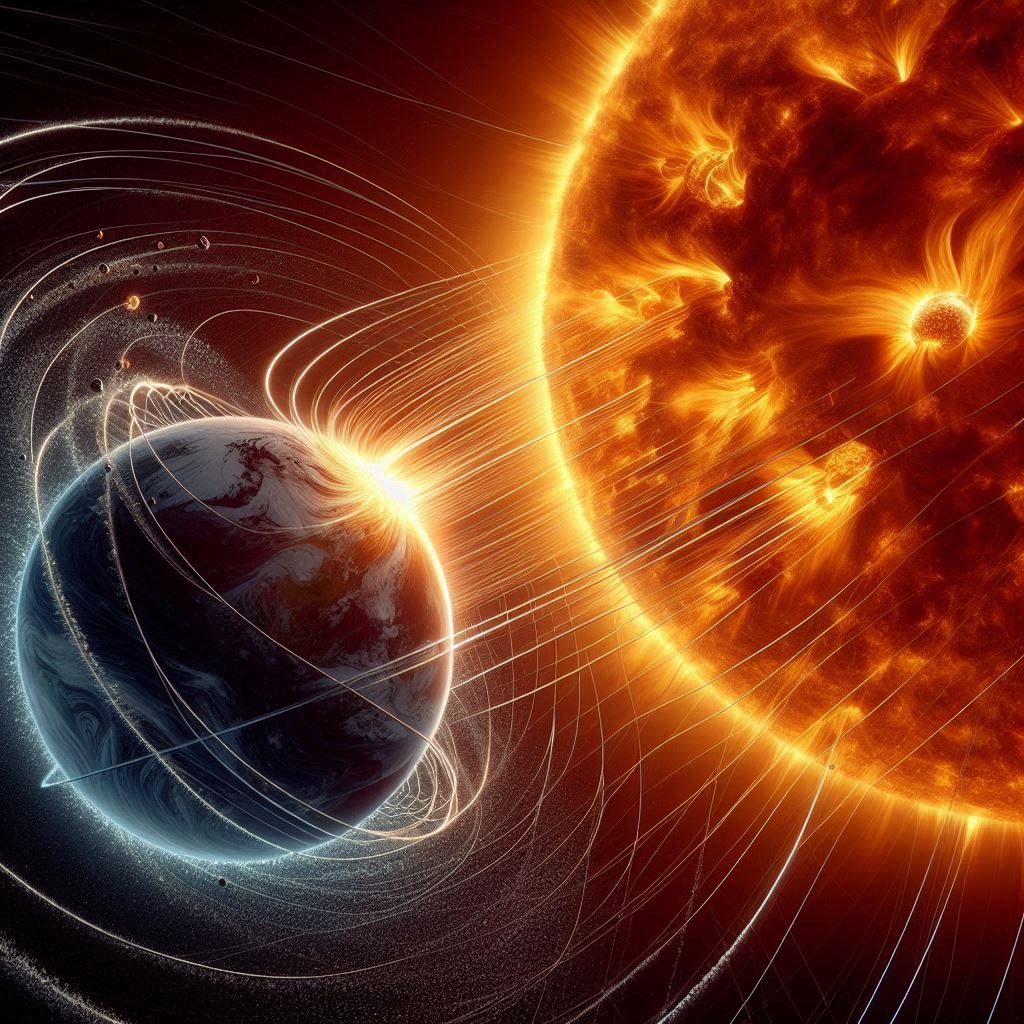Contents
- 1 When the Sun Reaches Out: Understanding Coronal Mass Ejections
- 2 Prof. Aécio D’Silva, Ph.D AquaUniversity
- 3 In the vastness of space, the Sun’s wrath extends far beyond its fiery surface, sending shockwaves that challenge our technological resilience on Earth.
- 4 The Power Grid Under Siege – The Invisible Threat to Our Electrical Lifeline
- 5 Coronal Mass Ejections – Navigation Systems: The Hidden Vulnerability – When Compasses Fail
- 6 Radio Communications: Static Over the Airwaves – Disrupted Signals and Lost Connections
- 7 Coronal Mass Ejections – Satellite Operations: Orbits in Jeopardy – The Fragile Network Above
- 8 The Ripple Effect on Technology – A Cascade of Technological Troubles
- 9
- 10 A Timeline of Significant CME Events
- 11 Timeline of Notable CME Events
- 12 Coronal Mass Ejections – The Effect and Consequences of The Carrington Event
- 13
- 14 Coronal Mass Ejections – What precautions can we take to mitigate the impact of future solar storms?
- 15 Coronal Mass Ejections – What are the long-term effects of solar storms on Earth’s climate?
- 16 How do solar storms affect the ozone layer?
When the Sun Reaches Out: Understanding Coronal Mass Ejections
Prof. Aécio D’Silva, Ph.D
AquaUniversity
In the vastness of space, the Sun’s wrath extends far beyond its fiery surface, sending shockwaves that challenge our technological resilience on Earth.
Coronal Mass Ejections – The Sun, a seemingly constant source of light and life, harbors a dynamic and turbulent nature. Coronal mass ejections (CMEs) are particularly significant among its many solar activities due to their potential to disrupt our technologically dependent society.
The Power Grid Under Siege – The Invisible Threat to Our Electrical Lifeline
CMEs pose a serious threat to electrical power grids worldwide. These massive bursts of solar wind and magnetic fields can induce geomagnetic storms capable of distorting Earth’s magnetic field. This distortion can generate damaging electrical currents in power lines, transformers, and other electrical grid components, leading to widespread power outages.
Navigation systems, particularly those relying on geomagnetic orientation, are at risk during CME events. The disturbances in Earth’s magnetic field can cause significant deviations in navigational readings, leading to disorientation and potential hazards in both maritime and aerial travel.
Radio Communications: Static Over the Airwaves – Disrupted Signals and Lost Connections
High-frequency radio communications, which are crucial for aviation, emergency services, and remote communications, can be severely disrupted by CMEs. The ionospheric disturbances can lead to signal degradation or complete blackout periods.
Coronal Mass Ejections – Satellite Operations: Orbits in Jeopardy – The Fragile Network Above
Satellites, the backbone of global communications and Earth observation, are not immune to the effects of CMEs. The increased radiation and charged particles can damage satellite components, disrupt signals, and even alter satellite orbits, posing risks to GPS services and other critical satellite-based systems.
The Ripple Effect on Technology – A Cascade of Technological Troubles
The impact of CMEs extends to various facets of technology. From the potential loss of critical data to the failure of safety systems, the ripple effect can be profound. The reliance on technology in everyday life means that even a minor disruption can have significant consequences.
A Timeline of Significant CME Events
A timeline highlighting some significant coronal mass ejection (CME) events that have impacted Earth:
Timeline of Notable CME Events
- 1970s (Generation 1): The era of early space exploration and the first use of coronagraphs in space, providing the initial understanding of CMEs.
- 1980s (Generation 2): Advancements in solar observation technology led to a deeper understanding of CME characteristics and their potential impact on Earth.
- 1990s (Generation 3): Increased frequency of observations and the beginning of real-time space weather monitoring.
- 2000s (Generation 4): The SOHO and STEREO missions provided unprecedented 3D views of CMEs, enhancing prediction capabilities.
- 2010s (Generation 5): The SDO and Solar Probe Plus missions offered high-resolution data, improving the accuracy of CME tracking and forecasting.
- May 10, 2024: A strong geomagnetic storm, caused by multiple CMEs, reached Earth and continued to affect various technologies through the weekend.
This timeline provides a snapshot of how our understanding and monitoring of CMEs have evolved over the decades, leading to improved preparedness for these solar events. The inclusion of the most recent event in May 2024 serves as a reminder of the ongoing relevance of CMEs to our technologically reliant society.
Coronal Mass Ejections – The Effect and Consequences of The Carrington Event
The Most Intense Geomagnetic Storm in Recorded History, Peaking On 1–2 September 1859 During Solar Cycle 10.
The Carrington Event, which occurred on September 1-2, 1859, is the most intense geomagnetic storm on record. It was caused by a massive coronal mass ejection (CME) that collided with Earth’s magnetosphere, resulting in significant technological disruptions and natural phenomena.
Effects and Consequences:
- Technological Disruptions: The geomagnetic storm induced powerful electrical currents that wreaked havoc on the telegraph system, which was the main means of communication at the time. Telegraph stations experienced severe damage, with reports of telegraph poles throwing sparks and papers catching fire due to the electrical surge.
- Auroral Displays: The event caused spectacular auroral displays, with the Northern Lights visible as far south as the Caribbean. These auroras were so bright that they illuminated the night sky, turning night into day in some regions.
- Global Impact: The Carrington Event had a worldwide effect, with auroras reported globally and telegraph systems across Europe and North America being disrupted.
- Navigation and Compasses: Compasses went haywire due to the geomagnetic storm, leading to navigation issues for ships at sea.
- Electric Shocks: There were widespread stories of people receiving shocks from doorknobs and other metal objects due to the induction of electrical currents.
If a similar event were to occur today, the consequences could be even more severe due to our increased reliance on technology. Power grids could be disrupted, satellites could malfunction, and communication systems could fail. The potential for a modern-day Carrington Event underscores the importance of improving our infrastructure’s resilience to solar storms and developing better forecasting methods to predict such events.
Coronal Mass Ejections – What precautions can we take to mitigate the impact of future solar storms?
To mitigate the impact of future solar storms, we can take several precautions:
- Enhance Prediction and Monitoring: Improving the forecasting of solar storms is crucial. This involves investing in space weather research and monitoring systems to provide timely warnings.
- Strengthen Infrastructure: Power grids can be hardened against geomagnetic storms, which may include upgrading transformers and installing protective systems to manage sudden electrical surges.
- Satellite Protection: Designing satellites with more robust shielding and incorporating fail-safes to protect against the increased radiation and charged particles during solar storms.
- Communication Systems: Develop backup communication networks that can remain operational or quickly recover in the event of a solar storm-induced disruption.
- Public Awareness: Educating the public and relevant industries about the potential risks and the importance of preparedness for solar storms.
- International Collaboration: Working with international partners to share data and strategies for dealing with the global challenge posed by solar storms.
- Personal Preparedness: Individuals can prepare for potential disruptions by having emergency supplies, and alternative power sources like generators or solar panels, and staying informed about space weather alerts.
These measures can help reduce the vulnerability of critical systems and ensure a more resilient response to the challenges posed by solar activity.
Coronal Mass Ejections – What are the long-term effects of solar storms on Earth’s climate?
The long-term effects of solar storms on Earth’s climate are a subject of ongoing research and debate. While solar storms, which include coronal mass ejections (CMEs) and solar flares, can have immediate impacts on Earth’s magnetosphere and technology, their influence on climate is more subtle and complex.
Here’s what current scientific understanding suggests about the long-term effects of solar activity on Earth’s climate:
- Sunspots and Solar Wind: Sunspots and the solar wind have been studied for their potential impact on climate change. Sunspots, which are storms on the sun’s surface, have increased in activity over the last century, and the sun has become slightly brighter. However, the consensus among climate scientists is that these changes have minimal impact on global warming compared to human industrial activity.
- Solar Storms and Heat Waves: Solar storms do not cause heat waves on Earth. Most of the energy from solar storms is reflected back into space by Earth’s magnetic field, and it does not reach the planet’s surface to influence surface temperature.
- Solar Variability and Weather Patterns: While the Sun’s influence on long-term climate change is considered minimal, changes in the Sun’s energy output and its magnetic field can impact Earth’s atmosphere and weather systems in the short term.
Historical Climate Events: Some historical climate events, such as the Little Ice Age, have been linked to periods of low solar activity, like the Maunder Minimum. However, the overall energy received from the Sun is quite stable over long periods.
- Climate Change Predictions: Most up-to-date climate models, including those used by the Intergovernmental Panel on Climate Change (IPCC), incorporate the effects of the sun’s variable brightness in their calculations. The effects of solar activity are accounted for, but they are just one of many factors considered in climate change predictions.
In summary, while solar storms can affect Earth’s space environment and technological systems, their direct impact on Earth’s long-term climate is relatively small compared to other factors, especially human-induced changes. The primary concern with solar storms remains their potential to disrupt modern technology rather than to alter the climate significantly.
How do solar storms affect the ozone layer?
Solar storms, particularly those involving coronal mass ejections (CMEs), can have a significant impact on the ozone layer. When a solar storm occurs, it can send a stream of electrically charged particles, primarily protons, towards Earth. These particles interact with the Earth’s atmosphere and can lead to the depletion of ozone in the following ways:
- Chemical Reactions: The charged particles from solar storms break up molecules of atmospheric gases like nitrogen and water vapor. The resulting atoms and molecules, such as nitrogen oxides and hydrogen oxides, then react with ozone molecules, leading to a reduction in the ozone layer.
- Upper-Level Ozone Depletion: The upper-most areas of the ozone layer, particularly in the stratosphere, are most affected by these reactions. The depletion can be quite rapid and can last for weeks to months after a solar storm event.
- Longevity of Effects: The nitrogen oxides created by the interaction can last for several weeks to months, depending on where they end up in the atmosphere. If they descend into the middle stratosphere, they can remain there for an extended period, continuing to reduce ozone levels.
- Immediate Changes: Solar proton events, which are showers of protons associated with solar storms, can cause immediate changes in the atmosphere, providing a clear cause-and-effect scenario for ozone depletion.
While the overall impact on human health may not be significant, especially considering that most of the ozone loss documented in studies occurs over the northern polar region, the scientific understanding of how solar storms affect upper-level ozone is crucial. It helps scientists distinguish between natural and human-induced causes of ozone loss.
In summary, solar storms can temporarily reduce the amount of ozone in the Earth’s stratosphere, which is an essential layer that protects life on Earth from harmful ultraviolet radiation. The extent of the impact depends on the strength and frequency of the solar storms and the resulting chemical reactions in the atmosphere.
To conclude, the silent storm of coronal mass ejections represents a formidable challenge to our modern world. As we continue to advance technologically, we must develop robust systems and protocols to mitigate the effects of these solar phenomena and safeguard our societal functions.
References:
https://www.astronomy.com/science/a-large-solar-storm-could-knock-out-the-internet-and-power-grid-an-electrical-engineer-explains-how/.
https://www.noaa.gov/stories/strong-geomagnetic-storm-reaches-earth-continues-through-weekend.
https://earthsky.org/human-world/carrington-event-1859-solar-storm-effects-today/.
https://www.planetary.org/articles/should-you-be-worried-about-solar-storms
https://todayshomeowner.com/solar/guides/how-to-protect-your-home-from-solar-flares-and-solar-storms/.
https://www.scientificamerican.com/article/sun-spots-and-climate-change/
https://www.climate.gov/news-features/climate-qa/do-solar-storms-cause-heat-waves-earth
https://earthobservatory.nasa.gov/features/ProtonOzonehttps://spacenews.com/solar-storms-destroy-ozone-study-reconfirms/.
https://earthobservatory.nasa.gov/features/ProtonOzone.
https://spacenews.com/solar-storms-destroy-ozone-study-reconfirms/.






